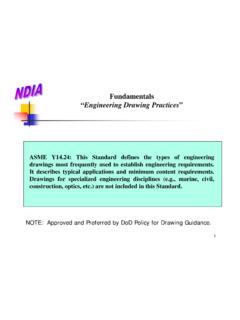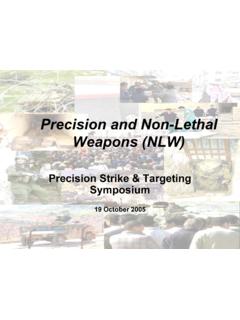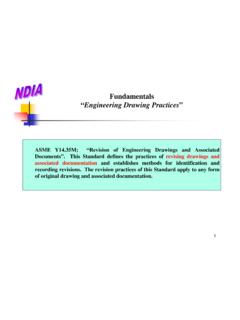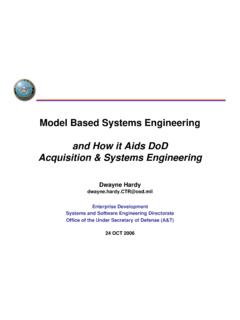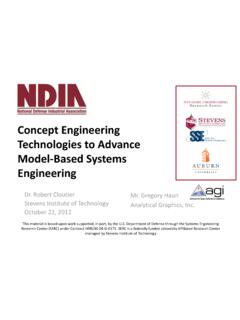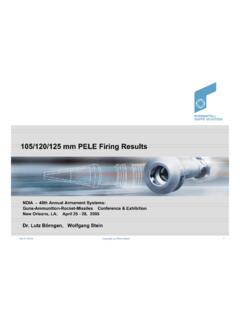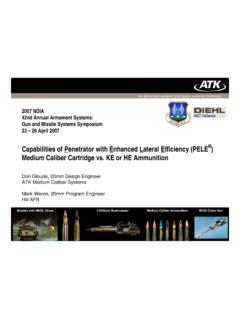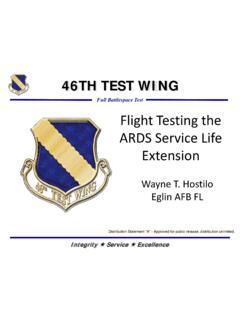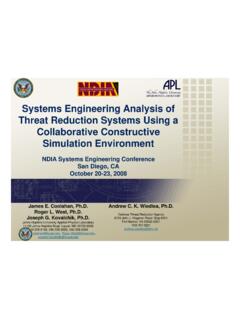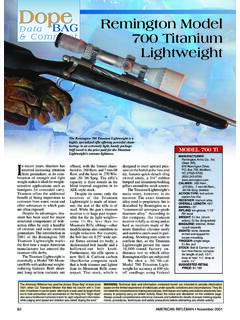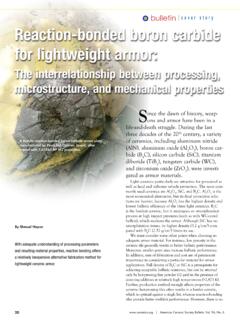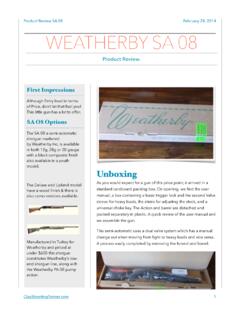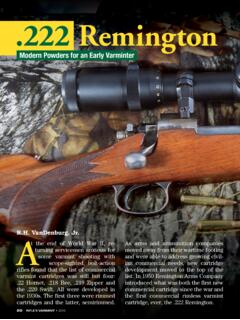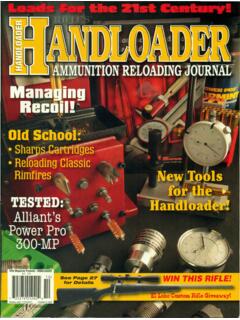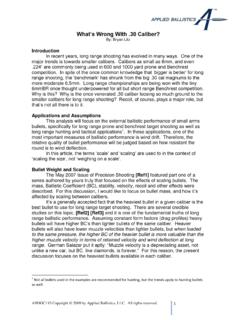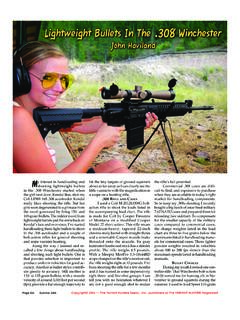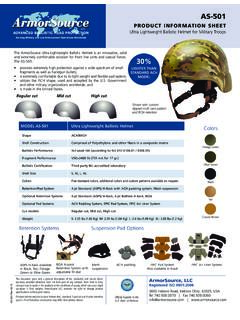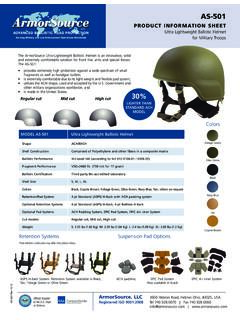Transcription of Lightweight Small Arms Technologies
1 1 Lightweight Small arms Technologies (LSAT)NDIA Small ArmsMay 2006Ms. Kori SpiegelUS Army ARDEC(973) Small arms TechnologiesNational Defense Industrial AssociationJoint Services Small arms SystemsAnnual SymposiumMay 2006Mr. Paul ShipleyAAI Corporation(410) Small arms Technologies (LSAT)JSSASTMay 2006 Lightweight Small arms TechnologiesTop 5 Soldier Weight ContributorsFor Automatic Squad Automatic Weapon w/200 rds Ammunition (400 rounds) Armor & Small arms Technologies (LSAT)NDIA Small ArmsMay 2006 Lightweight Small arms TechnologiesGoalsGoals: 35% weapon weight reduction 40% ammunition weight reduction Reduced training & maintenance Maintain cost of current systemsApproach: Clean Slate design Reduced weight as the priority In depth trade studies Extensive modeling & simulation4 Lightweight Small arms Technologies (LSAT)NDIA Small ArmsMay 2006 Lightweight Small arms Technologies Program ApproachLight Machine TelescopedAmmunition Achieve 50% overall weight reduction Pursue parallel Cased Telescoped and Caseless Ammunition design approaches High commonality of design and function, some action component differences Focus is development of Technologies -not specific weapon system Demo via Light Machine Gun with ammunition In parallel, Company Machine Gun study to determine feasibility of single weapon with a single round of ammunition for both LMG and MMGL ightweight Small arms Technologies (LSAT)NDIA Small ArmsMay 2006 Lightweight Small arms TechnologiesComparative Weights6 Lightweight Small arms Technologies (LSAT)
2 NDIA Small ArmsMay 2006 CTSystemCLDownSelect toSingleConceptSpiral 1 Spiral 2 Spiral 3 Spiral 4 Develop & TestBaseline CtgMann BarrelFabricate ActionControllabilityTestsHITP PropellantCharacterizationChamber SealTest & EvaluationOptimizeCartridgeBarrel TestsDevelop & TestBaseline CtgMann BarrelFabricate ActionOptimizeCartridgeTest ActionIntegrate CL WeaponTRL 5 TRL 6 Test Action33In-WorkIn-WorkLubricious CoatingsAnalysis & Tests3In-WorkIntegrate and Test CTA WeaponUpdate DesignHigh Temp WeaponMaterialsAnalysis & TestsSpiral Development Approach Each spiral represents successively higher system integration levels Exit criteria- Subsystem maturity sufficient for integration in next spiral Spiral duration varies per subsystem33In-WorkIn-WorkLightweight Small arms Technologies Concurrent & Leveraging Activities37 Lightweight Small arms Technologies (LSAT)NDIA Small ArmsMay 2006 Lightweight Small arms Technologies AAI Contractor Team Members ARDEC In-House Caseless Ammunition program (H&K/DN) ARL cartridge case and barrel material programs JSSAP BAA Component Contracts AAI Caseless Ammunition IR&D Program CRADA with ARDEC- H&K/DN Propellant characterization Johns Hopkins Applied Physics Lab- ModelingRelated ActivitiesPropellant for cased telescoped ammoStudy application of LOVA propellant for caseless ammunitionCaseless ammunition (H&K/DN)Cased telescoped ammo LAP Green ammunition conceptsSystem IntegratorIPT LeadsCaseless Weapon ActionIntegrated WeaponPhase II- AddWeapon ProducerVeritayThermal Testingand AnalysesJHU /APLC aseless Interior Ballistics AnalysisMSCW eapon Kinematic ModelingPTIP olymer Materials and FabricationTBDW eapon Producer8 Lightweight Small arms Technologies (LSAT)
3 NDIA Small ArmsMay 2006 Lightweight Small arms Technologies Integrated Product Team OrganizationMaterials Working GroupProgram ManagementIPTS ystem EngineeringIntegration & Test (SEIT) IPTW eapon IPTA mmunition IPTLMGA Executive CouncilSupportability IPTSE Mgt Working GroupCL Ammo Working GroupHSI Working GroupILS Working GroupTraining Working Group9 Lightweight Small arms Technologies (LSAT)NDIA Small ArmsMay 2006 Key Technologies Use of telescoped ammo-cased and caseless Lightweight materials & structural configuration Thermal management for weight reduction Barrel Caseless chamber components Caseless chamber sealing Human factors- firing controllability Integration of electronicsLightweight Small arms Technologies Weapon Design and Performance FeaturesMuzzle Compensator(Option)Fluted, Quick Change BarrelHigh stiffness and heat capacityNo tools for barrel changeFolding Front SightVentedForegripRotating Chamber providesIn-line push thru feed/ejectTop mounted flipopen feed trayDetachable Back up Iron Rear SightLong stroke, soft recoilImproves controllabilityMultiple Sling attach points for mission tailoringFull LoopPolymer Links100 Round Ammo Soft Pouch (150 for Caseless)Semi or Full Auto Fire @ 600 rd/minBoth M855 ball and M856 tracer bullets provide lethality equivalent to M249 Structural attachment points for mounting rails provided on both sides and top of foregrip Both cased telescoped and caseless configurationsRounds Counter improves maintainability10 Lightweight Small arms Technologies (LSAT)NDIA Small ArmsMay 2006 Key Technologies Telescoped cartridge Cased Ammunition Polymer cartridge case and endcap Compacted propellant (tracer rd)
4 Caseless Ammunition High Ignition Temperature Propellant Booster assisted interior ballistics Demonstrate in Address producibility Consider scalabilityLightweight Small arms TechnologiesAmmunition Design FeaturesM855 LSAT CTLSAT CLWeight 600 linked pkg'd lbs33% lbs51% reductionMuzzle velocity (78 ft)3,020 ft/sec3,020 ft/sec3,020 inchesPrimerPercussionPercussionPercussi on11 Lightweight Small arms Technologies (LSAT)NDIA Small ArmsMay 2006 Cased and Caseless Telescoped AmmunitionDesign and Development Status12 Lightweight Small arms Technologies (LSAT)NDIA Small ArmsMay 2006 Lightweight Small arms TechnologiesAmmunition Features Conventional technology in telescoped configuration Significant weight reduction Lower Risk High Ignition Temperature Propellant Technology Higher Weight Reduction Higher RiskCaseless ConfigurationCased Configuration13 Lightweight Small arms Technologies (LSAT)NDIA Small ArmsMay 2006 Lightweight Small arms TechnologiesCased Telescoped Ammunition Status (1) Technology demonstration with std bullet Completed Activities Development of Weapon Function Cartridge All telescoped ammunition features, but not optimized for weight/size Used to support initial weapon testing (SN CT1)
5 Activities nearing completion Development of Optimized Cartridge Reduces cartridge weight/size Approximately 750 rds fired to date Both Mann Barrel and Weapon Temperatures ranging from -65F to +145F14 Lightweight Small arms Technologies (LSAT)NDIA Small ArmsMay 2006 Lightweight Small arms TechnologiesCased Telescoped Ammunition Status (2) Interior ballistics results Achieved performance equivalent to M855 baseline (ie, Propellant Wt, Pch, Vm) Primer initiation parameters differ significantly from metallic case Case/End Cap material and geometry results Approximately 15 materials tested using injection molded cases. Numerous geometry variations tested- primer interface, bullet interface, cartridge sealing, case thickness profile Baseline selected, currently preparing final test seriesCrackedCaseSuccessful CaseMolded Case Material Examples15 Lightweight Small arms Technologies (LSAT)NDIA Small ArmsMay 2006 Significant level of cooperative test and analysis activities between ARDEC and contractor team Objectives Characterize chemical and physical characteristics of High Ignition Temperature Propellant (HITP) Replicate HITP to match ballistic and mechanical properties of ACR ammunition Demonstrate HITP production feasibility Process simplification Process control Process scalability Deliver prototype caseless ammunition for ballistic demonstrationLightweight Small arms TechnologiesCaseless Ammunition Status (1)16 Lightweight Small arms Technologies (LSAT)
6 NDIA Small ArmsMay 2006 HITP Materials & Process Development9 Characterize safety & physical properties of raw materials9 Identify material sources and/or synthesize9 Develop propellant mixing & fabrication process9 Characterize and replicate HITP thermal & ballistic characteristics Integrated Cartridge Demonstration9 Design & build proof-of-concept tooling for fabrication studies Fabricate both (ACR) and cases Fabricate primer cups Fire cartridges in Mann Barrel for comparison with ACR ammo Match ballistic performance through process & formulation improvements Use cartridge fabrication process as baseline for cartridge productionLightweight Small arms TechnologiesCaseless Ammunition Status (2)17 Lightweight Small arms Technologies (LSAT)NDIA Small ArmsMay 2006 Overview of ATK Streamlined HITP Process Fourteen D-N processing steps were significantly reduced, resulting in significant reduction in cycle time and production costsIngredient 1 Ingredient 2 Ingredient 3 Ingredient 4 Ingredient 5 Ingredient 9 Ingredient 6 Ingredient 10 PremixIngredient 8 Ingredient 7 Mix 1 Mix 2 Mix 3 Ingredient 1 Mix 4 Mix 5 Case FinishingD-N14 ProcessStepsATK2 ProcessStepsLightweight Small arms TechnologiesCaseless Ammunition Fabrication Process18 Lightweight Small arms Technologies (LSAT)NDIA Small ArmsMay 2006 Fabricated using improved process Duplicates ACR configuration Demonstrated good dimensional match to ACR ammunition with improved process approach Preparing to conduct ballistic comparison testing vs.
7 Residual ACR ammunitionAssembled ACRGood surface finish and feature control possibleLightweight Small arms TechnologiesCompleted HITP Cartridge Bodies19 Lightweight Small arms Technologies (LSAT)NDIA Small ArmsMay 2006 Fabricated using improved process, cylindrical cartridge configuration Demonstrated good dimensional control Preparing to conduct ballistic testing once cartridge demonstration testing completeFormed End Cap seatFormedPrimer CupNozzleVery uniformsurface finishLightweight Small arms TechnologiesCompleted HITP Cartridge Bodies20 Lightweight Small arms Technologies (LSAT)NDIA Small ArmsMay 2006 Specialized HITP formulation developed for Primer Cup Cups are loaded with off-the-shelf primer composition and inserted into caseless cartridge bodies Cups are sized to universally fit into or case configurations Demonstrated good dimensional control and good mechanical properties with processing that is amenable to high-rate production Preparing to conduct primer charging testsPrimer Cup for both and case configurationsLightweight Small arms TechnologiesCompleted HITP Primer Cups21 Lightweight Small arms Technologies (LSAT)
8 NDIA Small ArmsMay 2006 Thermal stability and characteristics of HITP were studied through surface heat hot-plate cook-off testing Results compared well with published data Threshold cook-off temperature was determined to be significantly higher than conventional NC ball powderLightweight Small arms TechnologiesHITP Thermal Characterization22 Lightweight Small arms Technologies (LSAT)NDIA Small ArmsMay 2006 High pressure closed bomb testing performed on HITP pellets & cartridges Effects of variation on burn rate being studied Process changes Formulation changes Optimal formulation testing continuesLightweight Small arms TechnologiesHITP Burn Rate Studies23 Lightweight Small arms Technologies (LSAT)NDIA Small ArmsMay 2006 Caseless ammunition provides 50% weight reduction vs. standard ammunition Accomplishments Demonstrated ability to replicate ACR HITP Demonstrated manufacture of dimensionally accurate propellant bodies and primer cups using a process scaleable to production Upcoming Milestones Cartridge integration- & Validation of integration of ATK cartridge performance vs.
9 ACR cartridges using Mann Barrel Firing of confidence cartridges to demonstrate scale-up to Small arms TechnologiesCaseless Ammunition Summary24 Lightweight Small arms Technologies (LSAT)NDIA Small ArmsMay 2006 Cased and Caseless WeaponDesign and Development Status25 Lightweight Small arms Technologies (LSAT)NDIA Small ArmsMay 2006 Lightweight Small arms TechnologiesCT Weapon Kinematic Model (2) Weapon Kinematic Modeling Approach MSC ADAMS software Model developed by MSC All geometry derived from weapon and ammunition 3D solid models All functional parts modeled- correct size, weight, stiffness, contacts Purpose of Model Verify geometric clearances and component ranges of motion Provide full kinematic characterization of weapon and ammo Develop component loads for FEA analysis Identify potential issues/solutions during design process Validate based on test data, then support diagnosis/correction of problems identified during firings Support integrated weapon analyses- drop, vibration etc26 Lightweight Small arms Technologies (LSAT)NDIA Small ArmsMay 2006 Lightweight Small arms TechnologiesCT Weapon Kinematic Model (3) Representative initial design issues identified via ADAMS model Feed pawl over-ride.
10 Corrected via revised pawl geometry Rammer bounce: added lock to design Chamber bounce: revised initial lock design Inconsistent ejection: elected to monitor during tests Significant belt whip: elected to monitor during tests Representative design studies conducted using ADAMS model Sensitivity to friction Effect of gas pulse profile Link stiffness effects- stresses and belt pull Belt support options Integration with MSC NASTRAN and LS DYNA to evaluate stresses, deformations, and contact loads Modeling enabled significant reduction i
